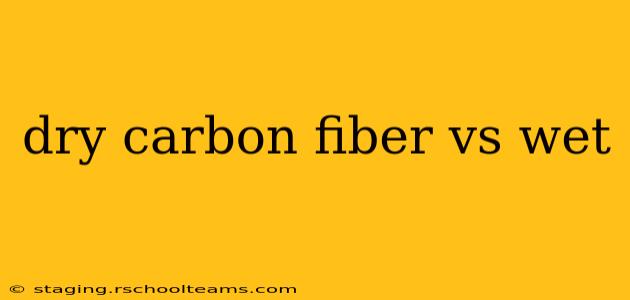Carbon fiber is a remarkable material, prized for its incredible strength-to-weight ratio. But within the world of carbon fiber composites, there's a key distinction: dry carbon fiber versus wet carbon fiber. Understanding the differences between these two methods is crucial for anyone involved in design, manufacturing, or simply appreciating the intricacies of this advanced material. This detailed comparison will delve into the processes, properties, and applications of each.
What is Dry Carbon Fiber?
Dry carbon fiber refers to a prepreg manufacturing process. "Prepreg" stands for pre-impregnated, meaning the carbon fibers are already saturated with resin in a controlled environment before being laid up. This pre-impregnation ensures consistent resin distribution and precise control over fiber orientation. The resin is typically partially cured, making it tacky but not fully hardened. This allows for easy handling and layup, but still requires curing in an autoclave or oven under precise temperature and pressure conditions to fully harden the resin and bond the fibers.
Advantages of Dry Carbon Fiber:
- Higher Strength and Stiffness: The controlled resin distribution in dry carbon fiber leads to superior mechanical properties, resulting in stronger and stiffer parts compared to wet layup.
- Improved Surface Finish: The pre-impregnated nature allows for a smoother, more consistent surface finish, often requiring less post-processing.
- Better Reproducibility: The pre-determined resin content and fiber orientation ensure greater repeatability and consistency in the final product.
- Complex Shapes: Dry carbon fiber is well-suited for complex geometries, making it ideal for high-performance applications where intricate shapes are essential.
Disadvantages of Dry Carbon Fiber:
- Higher Cost: The pre-impregnation process and specialized equipment required for curing (autoclaves) significantly increase the cost compared to wet layup.
- Shelf Life Limitations: Prepreg materials have a limited shelf life due to the partially cured resin. Proper storage and handling are essential.
- Specialized Expertise: Working with prepreg requires specialized skills and knowledge to ensure proper handling and curing.
What is Wet Carbon Fiber?
Wet carbon fiber, also known as wet layup, involves manually applying resin to the dry carbon fibers during the layup process. This method is simpler and less capital-intensive compared to dry carbon fiber. The resin is applied directly onto the fibers, often using brushes or rollers, and then the layers are consolidated to remove air bubbles and excess resin. The final curing occurs in an oven or under ambient conditions, but the process is less controlled than autoclave curing.
Advantages of Wet Carbon Fiber:
- Lower Cost: The simplified process and lack of specialized equipment make wet layup a significantly more affordable option.
- Greater Flexibility: Wet layup allows for greater flexibility in design and prototyping.
- Easier to Learn: The technique is easier to learn and master, requiring less specialized training.
Disadvantages of Wet Carbon Fiber:
- Lower Strength and Stiffness: The less-controlled resin distribution can lead to lower mechanical properties compared to dry carbon fiber.
- Inconsistent Properties: The manual application of resin can lead to variations in resin content and fiber orientation, resulting in inconsistencies in the final product.
- Difficult for Complex Shapes: Wet layup is more challenging for complex shapes, and achieving a high-quality finish can be difficult.
Which Method is Right for You?
The choice between dry and wet carbon fiber depends largely on the specific application, budget, and required properties. High-performance applications, such as aerospace, automotive racing, and high-end sporting goods, generally favor dry carbon fiber for its superior strength, stiffness, and consistency. Wet layup is better suited for smaller-scale projects, prototyping, or applications where cost is a primary concern and the mechanical requirements are less demanding.
Frequently Asked Questions (FAQ)
H2: What is the difference in the curing process between dry and wet carbon fiber?
Dry carbon fiber uses an autoclave, providing precise temperature and pressure control for optimal resin cure and fiber bonding. Wet carbon fiber curing is less precise, often using ovens or ambient curing, leading to potentially less consistent results.
H2: Can you mix dry and wet carbon fiber in a single part?
While technically possible, it's generally not recommended due to the different curing processes and potential for inconsistencies in the final product. Different resin systems and curing cycles could lead to delamination or other issues.
H2: Which type of carbon fiber is stronger?
Dry carbon fiber typically exhibits higher strength and stiffness due to the controlled resin distribution and precise fiber orientation achieved during the prepreg process.
H2: Which type of carbon fiber is more expensive?
Dry carbon fiber is significantly more expensive than wet carbon fiber due to the cost of prepreg materials, specialized equipment, and the more complex manufacturing process.
H2: Which method is better for beginners?
Wet layup is generally considered easier for beginners to learn due to its simpler process and less specialized equipment.
This comparison provides a thorough overview of dry and wet carbon fiber processes, highlighting their advantages and disadvantages to assist in making informed decisions based on specific project needs and priorities. Remember to always prioritize safety when working with carbon fiber composites.
